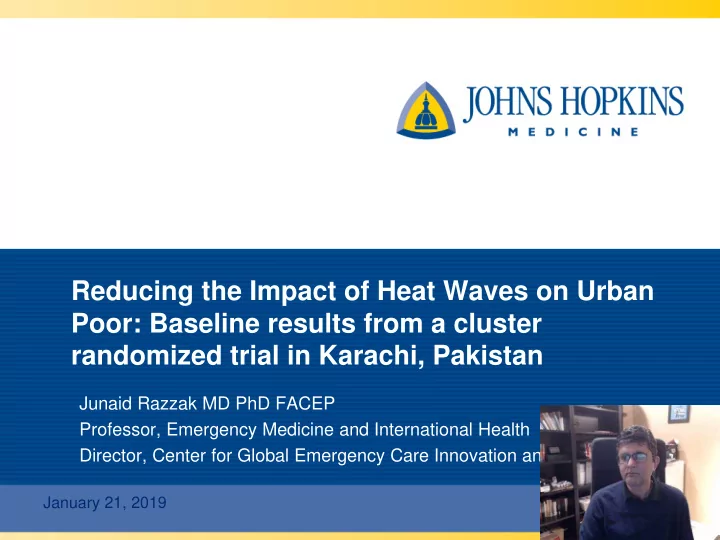

Reducing the Impact of Heat Waves on Urban Poor: Baseline results from a cluster randomized trial in Karachi, Pakistan Junaid Razzak MD PhD FACEP Professor, Emergency Medicine and International Health Director, Center for Global Emergency Care Innovation and Training January 21, 2019 1
Partners • Johns Hopkins University School of Medicine (Ms. Chelsea Ducielle, Drs. Adnan Hyder, Richard Rothman) • Aga Khan University, Pakistan (Drs. Nadeemullah Khan, Uzma Khan) • Aman Foundation, Pakistan (Mr. Zaheer Chand, Dr. Sadia Quraishy) • Alliance for Health Policy and Systems Research, World Health Organization (Dr. Abdul Ghaffar) Funded by ELRHA (R2HC), UK
Current Research • There is significant gap in public health research on extreme heat, especially from countries with the highest risk. • All population based estimates for public health interventions have been primarily observational data. • A recent systematic review on the impact of heat adaptation strategies on heat related mortality found a total of 30 articles, of which 29 were from high income countries. • The single RCT evaluated the impact of homecare on hospital admissions amongst elderly
Challenges to conducting research in heatwaves. 1. There is no universally acceptable definition of exposure - extreme heat and heatwaves. 12,13 2. Lack of clearly defined health consequences of heat exposure makes it difficult to ascertain true health burden of heatwaves. 3. Specific heat-related illnesses such as heat stroke, heat exhaustion, and heat syncope are often difficult to reliably capture in areas where fever and sepsis are common causes of death.
• State of Maryland Karachi • State of Delaware Population: 24 • State of Pennsylvania Million • Washington DC • Half of State of New Jersey Delaware Karachi Area: 2489 sq Area: 1426 sq miles miles
Objective/Specific Aims • 1: To develop evidence based care strategies for management of people with exposure to extreme heat (EH) in both households and emergency departments in low income settings such as Pakistan (Heat Emergency Education and Training Bundle) • 2: To implement Heat Emergency Education and Training (HEAT) bundle in Karachi and measure its impact on a composite outcome comprising of emergency department admissions, hospital admissions and all-cause mortality • 3: To determine the impact of HEAT implementation on the knowledge and care practices in households and emergency departments.
Methodology • Community –Design: Pre and Post as well as Cluster Randomized Trial design –16 clusters of 1000 population –Setting: Korangi, Karachi, Pakistan • Hospitals –Pre and Post design –4 hospitals serving the study area (but also other areas)
Study Design - Community Component • Phase 1: Baseline data – May-Jul, 2017, baseline community surveillance • Phase 2: Community Awareness Interventions/Activities (Jan-Apr 2018) – Community mobilization: Targeting community leaders, schools, mosques – Each CHW conducted 2 health education sessions a day in March/April, 2018 at homes in the community – SMS with health messages; and linked to call center for any questions – Pamphlets/flyers were distributed • Phase 3: Post-Intervention data collection (May-Sep 2018) – KAP survey (before and after) – Hospital admissions and deaths in the community (before and after) – Recall of SMS messages
Study Design – Hospital Arm • What is the setting of our study? – Four major hospitals in/close to the Korangi District • Our intervention – Development of heat emergency management protocol – Training of emergency physicians and nurses through a one and half day workshop – Placement of protocols in emergency department resuscitation areas • What are we measuring – Pre and post test of knowledge of physicians and nurses – Number of admissions with suspected heat emergency to the emergency department and to the hospital – Number of deaths due to suspected heat emergencies – Review of quality indicators for suspected heat emergency patients
Methodology II Pre-Intervention Phase (5/17-7/17) Development of HEEET Tool Box (3 groups of 4-6 experts Baseline Data Collection (ED Surveillance/ Community both from high and low income countries using Delphi Surveillance & Provider Interviews) technique) Intervention (1/18-4/18) Community: Community Awareness through mobilization Hospital Care: Training of ED staff & availability of basic activities followed by SMS messages supplies. (Cluster Randomized trial) (4 ED – 2 in intervention and 2 in control arm) Post-Intervention Data Collection (5/18-7/18) ED Surveillance for mortality and morbidity due to heat Community Surveillance and Community Interviews emergencies/ Provider interviews and post-training scores
Temperature (Heat Index) during the baseline period 180 160 140 Extremely Dangerous 120 100 Dangerous 80 60 40 20 0 1/21/2019 17
Baseline data – Community/Household characteristics Number of households 2712 Population covered 16973 Avg HH size (# of people/house) 6.3 Avg number of rooms/house 1.8 Tap water available 54.10% Uninterrupted water supply 27.70% Electric power available 89%
Baseline data – Hospitals (10 weeks) Total patients Total ED Total Total DOA/ED suspected of visits Admissions deaths heat illness JPMC 106813 16489 1208 1419 Chiniot 16336 2972 52 325 Korangi 59390 1088 469 1534 Indus 40058 2314 182 915 Total 222597 22863 1911 4193 1/21/2019 19
Next Steps • Analysis of endline data • Dissemination of findings 1/21/2019 23
Recommend
More recommend